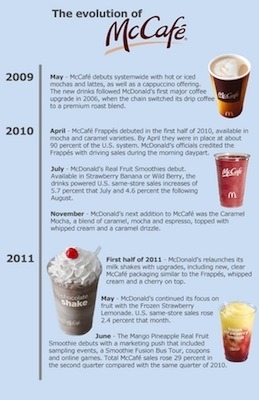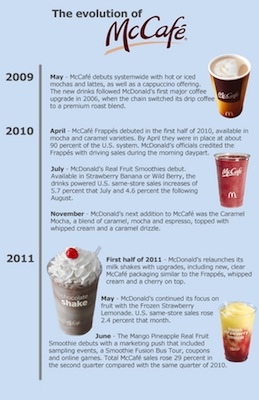McDonald's McCafé: An Evolution
Over the past several years, McDonald's Corp.'s sales growth has outpaced many of its major quick-service peers in the United States. While company executives credit a balanced approach of marketing core products, its Dollar Menu, and premium items like Angus Third Pounders, they also regularly have cited the McCafé beverage line as a major sales driver.
Since its nationwide rollout in May 2009, McCafé has helped McDonald's grow its coffee sales from 2 percent of U.S. sales to more than 6 percent, while combining with the Breakfast Dollar Menu to strengthen a morning daypart in which the chain is considered a pioneer and leader.
Timeline: Take a quick look at how McCafé has changed over time
But as McDonald's has expanded McCafé from espresso-based drinks to include premium frozen beverages like Frappés and Real Fruit Smoothies, the platform continues to support growing increases in same-store sales. The following is a look at the evolution of McCafé, from its first lattes and cappuccinos to its Mango Pineapple Real Fruit Smoothie, launched in June.
First up: McCafé debuts and McCafé Frappés
McCafé(May 2009)
McCafé debuted systemwide May 5, 2009. The program had been in test since November of 2007, officials said. The platform began with hot or iced mochas and lattes, as well as a cappuccino offering. The new drinks followed McDonald's first major coffee upgrade, switching its drip coffee to a premium roast blend in 2006.
At the time, McDonald's internal goals for McCafé were to increase annual average unit volumes by about $125,000, and officials reported to investors that the chain was solidly on its way to hitting that mark, even before blended drinks like Frappés and Real Fruit Smoothies were ready for rollout.
The chain began the first of many aggressive marketing campaigns for McCafé in July 2009, doing a "Mocha Mondays" promotion that offered a free 7-ounce iced mocha or 8-ounce hot mocha as a sample.
While initial sales lifts in the United States were smaller than those of the past few months for McDonald's, the restaurant industry in mid-2009 — particularly the quick-service segment — already was beginning to feel the impact of growing national unemployment. McDonald's domestic same-store sales rose 1.8 percent in June of 2009. Comparable-sales in July of that year rose 2.6 percent, even accounting for the popularity of McCafé and the introduction of the Angus Third Pounders.
"If you look at the espresso base, clearly we've more than doubled since the first part of just 2009," Don Thompson, McDonald's chief operating officer, said during the first-quarter 2010 earnings call. "All of the coffee strategies have been intended to really bring in more customers. We talked earlier about the incremental nature of it and about 40-odd percent of the customers being incremental.
"That still holds true even as we move into frappés, which is still a coffee-based, espresso-based drink," he said. "So, all of our measures and metrics in terms of coffee have moved in a positive direction substantially."
Earlier this year, chief executive Jim Skinner said popularity of the hot espresso drinks during the winter months drove a 17-percent increase in first-quarter McCafé sales compared with 2010.
McCafé Frappés (First half of 2010)
McCafé Frappés, the chain's blended-drink answer to Starbucks Coffee's Frappuccino, began rolling out over the first half of 2010, and by April of that year they were in place at about 90 percent of the U.S. system. The beverages were available in mocha and caramel varieties.
McDonald's officials said during the first few months of Frappés' launch — which coincided with testing Real Fruit Smoothies — that interspersing advertisements for the high-margin drinks with marketing campaigns for core menu items and value offers like the Dollar Menu benefitted McDonald's margins.
Another added benefit of Frappés was the relatively high incidence of sales during the morning daypart. Executives said 30 percent of Frappé sales occurred at breakfast, which was a slight increase from the 25 percent that had happened during tests of the product.
Next: Original Real Fruit Smoothies and Caramel Mocha
Original Real Fruit Smoothies (July 2010)
In July 2010, McDonald's rolled out to its U.S. system the Real Fruit Smoothie, available in Strawberry Banana or Wild Berry. The drinks powered same-store sales increases in the United States of 5.7 percent that July and 4.6 percent the following August, executives said.
The marketing campaign also proved to be quite popular, helping McDonald's gain market share for the product that exceeded initial goals. According to its official entry for the Effie Awards, an advertising competition, McDonald's executed a $40 million campaign that took it from zero percent market share for smoothies in the United States to 20.1 percent, four times its official goal of 5 percent.
Awareness was so widespread for the new products that McDonald's had to cancel a national sampling event.
"The company is blowing away the high-end projections we had for smoothie sales," Thompson said in the official entry.
(November 2010)
McDonald's next addition to McCafé was the Caramel Mocha, a blend of caramel, mocha and espresso, topped with whipped cream and a caramel drizzle. The big marketing push for this drink, during November and December of 2010, was a "McCafé Caramel Mocha Scavenger Hunt" for three giant McCafé cups hidden in eight cities, offering a year's worth of free McCafé beverages. Participating markets included Atlanta; Chicago; Cincinnati; Dallas; Los Angeles; New Haven, Conn.; Salt Lake City; Tampa Bay, Fla.; and Washington.
Next: New milkshakes and Frozen Strawberry Lemonade
New milkshakes (First half of 2011)
In the first half of 2011, McDonald's relaunched its milk shakes to include new clear McCafé packaging similar to the Frappés. The shakes also got the upscale treatment with whipped cream and a cherry. Officials reiterated that promoting McCafé drinks, including the new milk shakes, was more accretive to margins and the average check.
"The McCafé average check is higher than our other average checks in the restaurant," Thompson said during the first-quarter earnings call of 2011. "And when you look at McCafé, it's always a trade up when that drink is purchased. So we feel real good about the ongoing progress that we have and opportunity in McCafé."
Frozen Strawberry Lemonade (May 2011)
McDonald's continued its focus on fruit with the Frozen Strawberry Lemonade, which infused a frozen lemonade with a strawberry puree. National advertising for the beverage began in May, the same month in which McDonald's took a 1.4-percent price increase on top of a 1-percent menu price hike in March 2011.
Same-store sales in May 2011 in the United States grew 2.4 percent.
Next: Mango Pineapple Real Fruit Smoothie
Mango Pineapple Real Fruit Smoothie (June 2011)
The Mango Pineapple Real Fruit Smoothie debuted June 27, 2011, and McDonald's put another giant marketing push behind the drink, not only with national television ads but also with sampling events, a Smoothie Fusion Bus Tour traveling to different events catering to Hispanic and African-American customers, and several coupon offers.
McDonald's executed $1 tear-off coupons on its drink packaging to promote the new smoothie flavor and supplemented that with a digital buy-one-get-one offer and national Sunday inserts. It also reprised its popular "spin art" online game used to promote the previous year's smoothie launch, this time with complementary apps for the iPhone and iPad.
The Mango Pineapple Real Fruit Smoothie contributed to McDonald's 4.4-percent increase in July 2011 same-store sales, officials said, which faced a tough comparison in the 5.7-percent comp of July 2010. Securities analyst John Glass of Morgan Stanley noted that price increases accounted for about 2.4 percent of that result.
Total McCafé sales rose 29 percent in the second quarter compared with the same quarter of 2010, Thompson said during a conference call with investors.
"From a percent-of-sales perspective, we still view ourselves as an underdog in frozen beverages," Thompson said. "Being the underdog is a great thing because we have even more opportunity to take share, and we can do it at the speed of McDonald's."
Oak Brook, Ill.-based McDonald's operates or franchises more than 33,000 restaurants worldwide, including more than 14,000 locations in the United States.
— Mark Brandau

